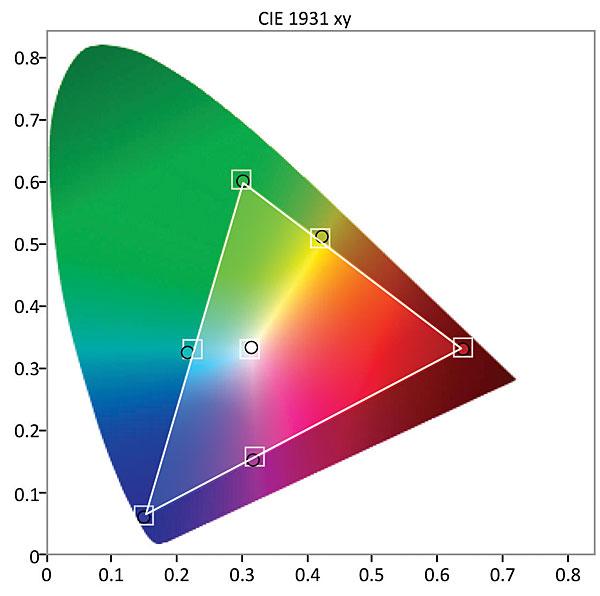Panasonic Viera TC-P60ST60 3D Plasma HDTV HT Labs Measures
Full-On/Full-Off Contrast Ratio: 13,208:1
All the post-calibration measurements shown here and all the observations in the review itself unless noted otherwise were performed in the Cinema picture mode for 2D or Custom picture mode for 3D, through an HDMI input with the set adjusted as needed for the most accurate image in a darkened room. Measurements were taken with a Klein K-10A colorimeter using SpectraCal CalMAN 5 software and an AV Foundry VideoForge signal generator.
The 2D contrast ratio was measured at a Contrast setting of 82, a Brightness setting of 2, a Gamma setting of 2.4, and Panel brightness set to Mid. The peak white level with these settings was 31.7 foot-lamberts, and the black level was 0.0024 ft-L.

Color-tracking charts were generated in SpectraCal CalMAN, www.SpectraCal.com
The pre-calibration RGB balance shown in the charts was taken in the default Cinema mode. The precalibration Delta E values ranged from 2.78 at 90 percent brightness to a high of 8.2 at 20 percent, with the average 5.0 from 20 IRE to 100 IRE; Delta E remained under 4.0 down to 60 percent but rose in the darker windows. Calibration using the set’s two-point and 10-point white balance controls yielded an excellent result. Post-calibration, the low was 1.0 at 70 percent and stayed below 1.7 for most of the brightness range, climbing above that only in the 20 percent window where it hit 2.7; the average Delta E was 1.36.
(Delta E is a figure of merit that indicates how closely a display adheres to the HD color standard. Experts generally agree that a level below 3 to 4 indicates a result that’s visibly indistinguishable from perfect color tracking.)
In the Normal color space setting, the set’s post-calibration 2D color gamut closely followed the Rec. 709 HD standard with respect to both the location of color points as shown on the CIE chart as well as in luminance, but adjustments with the CMS controls for the red, green, and blue primaries were required to achieve this (no controls are provided for the secondary colors cyan, magenta, and yellow). Pre-calibrated Delta E values averaged 2.6; postcalibration, this dropped to 0.88, with yellow and cyan the biggest offenders at 1.6.

The Panasonic’s gamma in the 2D Cinema mode, at a setting of 2.4 and after fine-tuning with the 10-point gamma adjustments, averaged 2.13, showing its most severe drop below the target value of 2.2 below 40 percent brightness.
The 3D calibration in the Custom mode (charts not shown) was not nearly as successful, although calibration improved the average Delta E from 12.4 to 5.9. With the 1.8 gamma setting selected after subjective observation of the image, the calibrated picture yielded an average gamma of 1.4. Peak white light output was only 4.5 ft-L. Despite the poor measurements, the ST60 delivered satisfying 3D images, albeit not terribly bright ones. It’s now common for manufacturers to achieve better subjective contrast for 3D playback with low gamma settings, which for some reason do not have the same effect of washing out the image they do with 2D images.

The ST60 passed our benchmark tests, though it required moving the 3:2 menu option from Auto to its On setting to pass the HD and SD 2:2 cadence tests. These 2:2 torture tests are common failures.—RS













































